The HP Spectre Folio Review: Luxurious Leather Laptop
by Brett Howse on June 7, 2019 8:00 AM EST- Posted in
- Laptops
- HP
- Spectre
- Amber Lake
- Spectre Folio
GPU Performance
Intel’s integrated graphics architecture has been somewhat stale for the last several generations, with small tweaks, and new media blocks, but no real performance increases or efficiency gains. The Intel UHD 615 in the HP Spectre Folio is further limited by an even more restrictive TDP.
Intel has been investing heavily in GPU recently though, and hopefully their next GPU architecture will address some of these shortcomings. But today we’ll see how the UHD 615 stacks up. Some laptops, such as the Lenovo ThinkPad A285, offer integrated AMD Vega graphics, and the Huawei MateBook X Pro features a low-powered NVIDIA GPU in the MX150, with the latest Huawei bumping that to the MX250.
3DMark
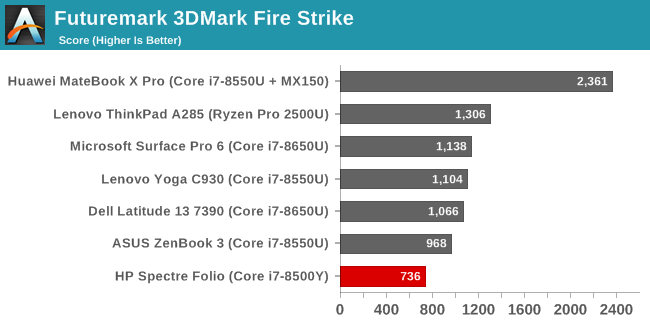
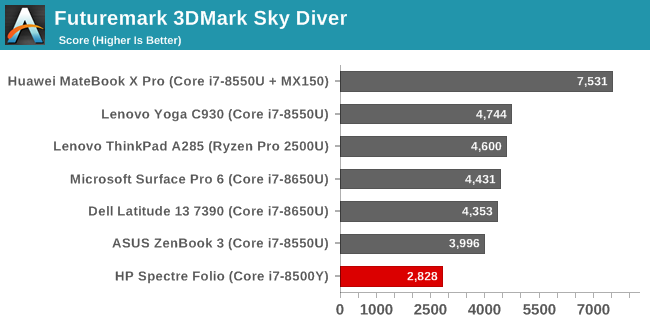
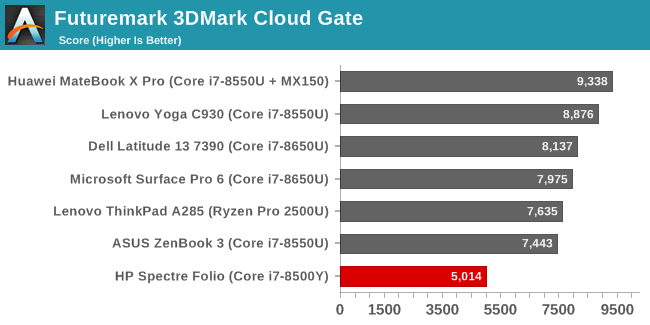
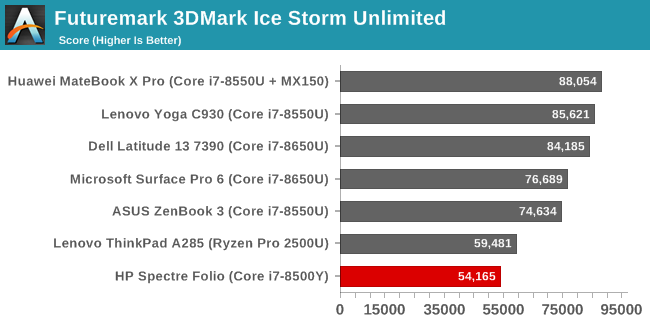
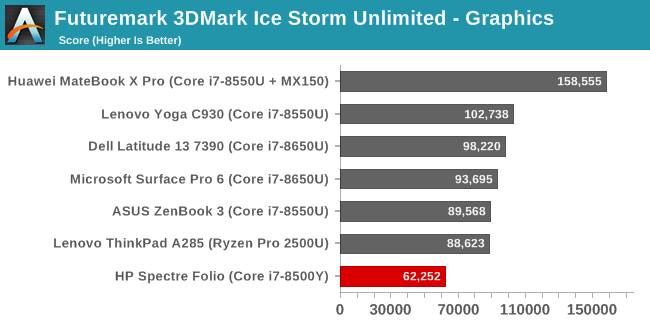

UL’s 3DMark offers different tasks with varying levels of complexity. Fire Strike is the most difficult we run on our laptop workloads, then Sky Diver, Cloud Gate, and Ice Storm Unlimited, the latter of which can also be run on tablets and smartphones. With just a 5-Watt TDP, the UHD 615 just can’t compete against the higher-powered laptops in our database.
GFXBench
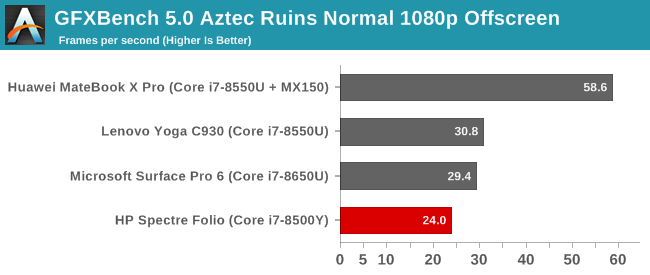
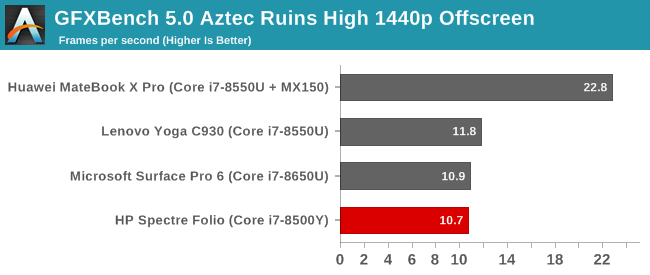
Our second synthetic test is the latest from Kishonti and the latest Aztec Ruins tests utilize DX12. Despite the newer API, the HP still falls in at the bottom of this list.
Dota 2
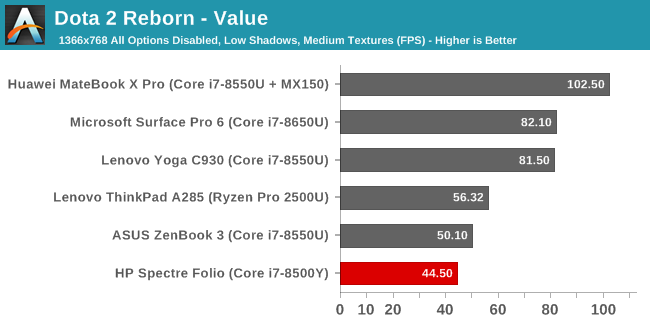
Looking at a real-world 3D game, Valve’s Dota 2 is a great test for low-end machines, since it is playable across a wide variety of hardware. It utilizes DX11 for its API, and we’ve tested it on our value settings which are 1366x768 with all of the effects disabled.
Dota 2 can be surprisingly CPU bound. This doesn’t exactly help the Spectre Folio though, since the CPU and GPU are both sharing the same 5-Watt TDP, and therefore one has to make way for the other. The result is not great framerate, although the game is still playable at 44 FPS.
Storage Performance
HP offers a wide selection of SSD options, from 256 GB all the way up to a massive 2 TB. All of the SSDs are NVMe PCIe based as well. The review unit features a Samsung PM961 based SSD which is 256 GB.
Performance is quite good, even with this being the smallest SSD available. Larger SSDs will of course bring more performance as well with the extra NAND offering more parallel channels for data access.


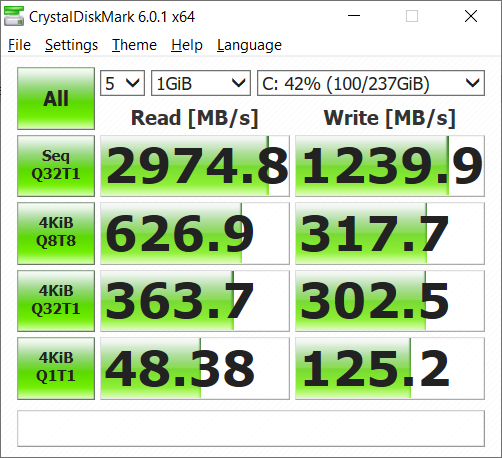








29 Comments
View All Comments
peevee - Friday, June 7, 2019 - link
What 5V/9V? Seriously, dude, stop posting the nonsense and go see a psychiatrist.wilsonkf - Friday, June 7, 2019 - link
Maybe he means USB-C power output? :PHStewart - Friday, June 7, 2019 - link
Please research before you post - Intel change the voltage on Y models from 5V to 9V. But this could also because WIFI 6 integrated in chip in addition Thunderbolt 3HStewart - Friday, June 7, 2019 - link
https://www.anandtech.com/show/14436/intel-10th-ge...bubblyboo - Friday, June 7, 2019 - link
Christ you're dumb. You mean 5W to 9W TDP, not 5V/9V. And it won't mean jack shit since Intel never has correct TDP either. It only means 10nm is a power hog as predicted.Hifihedgehog - Friday, June 7, 2019 - link
HStewart really started to lose his marbles ever since the time Ryzen 3000 was unveiled at Computex. I truly pity him.That said, I am not very hopeful that Ice Lake will be a very good performer at lower power. As Ian found with his review of the Cannon Lake based NUC, the silicon draws more power at a given frequency than previous generations. That leads me to believe their 10nm manufacturing process is particularly leaky. That would naturally explain why they had to raise the power rating on their Y-class/Core M products to a 9W TDP. Even with all the tweaks and workarounds they may have done at the logic level to ease the brunt of their broken process at the silicon level, power draw potentially remains as a serious issue.
Korguz - Friday, June 7, 2019 - link
hstewart.. please do your own research before YOU post.. its watts NOT voltage... as bubblyboo said.. intels cpus rarely run at the TDP they say.. these 5 WATT and 9 WATT cpus will probably run higher then that...Hifihedgehog - Friday, June 7, 2019 - link
Watts, not volts, dude.Thunderbolt is not always active and therefore it and the other features that got pulled into the CPU die shouldn't be contributing to such a high TDP. I am quite skeptical and wary of Ice Lake and I am thinking that their 10nm manufacturing process is leaky just like Cannon Lake was which contributed to its unusually high power draw.
Korguz - Friday, June 7, 2019 - link
HStewart... are you ok ?? did you fall on your head ?? do you have ANY idea what would happen if you put 5 or 9 VOLTS of power into a cpu ?? it would probably fry and die in a firery death... is your blind fan boyism so bad now you can think straightAshlayW - Friday, June 7, 2019 - link
To be fair, and old calculator contains a lot less complex technology than an Ultrathin notebook. So...